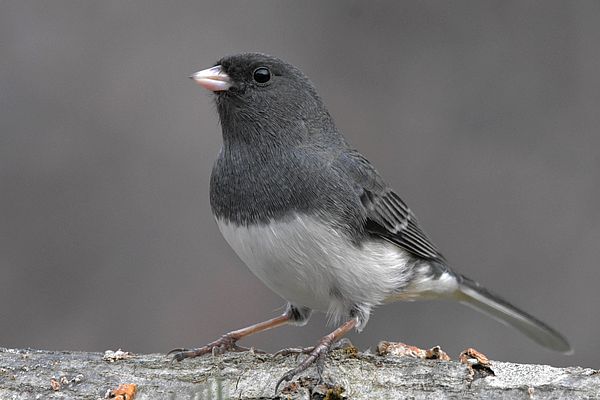Dark-eyed Junco (Slate-colored) – Snowbird
Article by Ava Steenstrup
Dark-eyed juncos, one of the most abundant species of New World Sparrow, are also one of the most widespread songbirds in North America. There is considerable variation in the plumage of male dark-eyed juncos across different parts of the continent. East of the plains, juncos are generally all gray and white. In the West, however, they come in various color patterns. Once called the “Snowbird”, the most common of the subspecies of juncos is the slate-colored.
Their simplicity makes them a standout among the more colorful winter birds. Adult dark-eyed juncos have gray heads, necks, and breasts, gray or brown backs and wings, and a white belly. The bright white outer tail feathers are especially apparent in flight and while hopping on the ground. The short bill is usually pale pinkish. True to their name, dark-eyed juncos have dark eyes.
Dark-eyed juncos live in deciduous, coniferous, and mixed forests particularly near the edges, open woodlands, shrubland, bogs, roadsides, and in the vicinity of farms. They are diurnal and spend their time foraging or perching. Dark-eyed juncos are social and, in winter, can often be found in flocks foraging on the ground for seeds under backyard feeders. They are also fond of forest floors rummaging through leaf debris and snow cover, brushy thickets, or weedy fields in search of seeds, grains, insects, and berries.
Dark-eyed juncos are monogamous and the male and female build a nest of grass, leaves, moss, and bark in a cup-shaped depression on the ground, well hidden by
overhanging vegetation. Their nests can occasionally be found in the lower branches of a shrub or tree. Dark-eyed juncos are regular breeders throughout western Massachusetts east to Worcester County as well as in Canada, the western U.S., and the Appalachians. The breeding season usually begins in April and up to three broods may be attempted per year.
The male’s song is a short, sweet trill on one pitch and its call is a hard, sharp chip, almost metallic in tone. Listen for their song in late March into April before they have flown to their breeding grounds.
Did you know? Dark-eyed juncos play an important role in their ecosystem. They help to maintain the forest in health and productivity. Due to their dietary habits, juncos disperse seeds and help to control populations of various insects they prey on.

